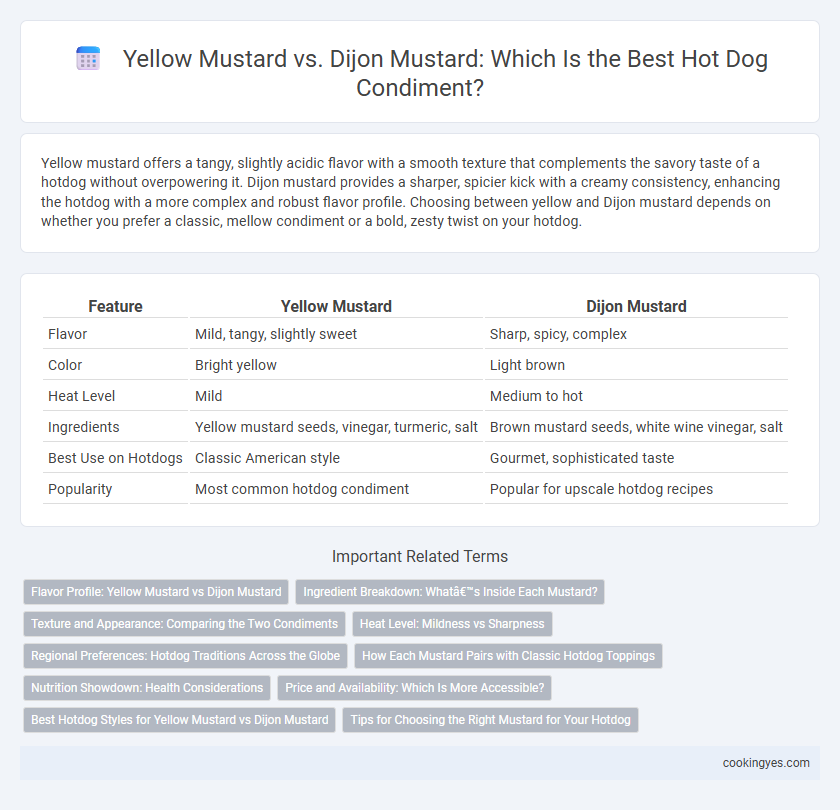Yellow mustard offers a tangy, slightly acidic flavor with a smooth texture that complements the savory taste of a hotdog without overpowering it. Dijon mustard provides a sharper, spicier kick with a creamy consistency, enhancing the hotdog with a more complex and robust flavor profile. Choosing between yellow and Dijon mustard depends on whether you prefer a classic, mellow condiment or a bold, zesty twist on your hotdog.
Table of Comparison
| Feature | Yellow Mustard | Dijon Mustard |
|---|---|---|
| Flavor | Mild, tangy, slightly sweet | Sharp, spicy, complex |
| Color | Bright yellow | Light brown |
| Heat Level | Mild | Medium to hot |
| Ingredients | Yellow mustard seeds, vinegar, turmeric, salt | Brown mustard seeds, white wine vinegar, salt |
| Best Use on Hotdogs | Classic American style | Gourmet, sophisticated taste |
| Popularity | Most common hotdog condiment | Popular for upscale hotdog recipes |
Flavor Profile: Yellow Mustard vs Dijon Mustard
Yellow mustard offers a tangy, mild, and slightly sweet flavor that complements the savory, smoky taste of hotdogs without overpowering them. Dijon mustard delivers a sharper, more complex and slightly spicy profile with hints of white wine and mustard seeds, enhancing the hotdog with a gourmet edge. Choosing between them depends on whether you prefer a classic, straightforward condiment or a more robust, sophisticated flavor experience.
Ingredient Breakdown: What’s Inside Each Mustard?
Yellow mustard primarily contains mustard seeds, vinegar, turmeric, salt, and spices, giving it a bright yellow color and a tangy, mild flavor perfect for classic hotdogs. Dijon mustard, made from brown or black mustard seeds, white wine or wine vinegar, water, and salt, offers a smoother texture and a sharper, more complex taste. The higher acidity and refined ingredients in Dijon create a gourmet twist, while yellow mustard's simple ingredient list supports a traditional, zesty flavor profile ideal for hotdog topping.
Texture and Appearance: Comparing the Two Condiments
Yellow mustard features a smooth, creamy texture with a vibrant, bright yellow color that enhances the classic hotdog appearance. Dijon mustard offers a slightly grainier texture and a pale, muted yellow hue with a hint of brown, providing a more sophisticated, rustic look. The contrasting textures and colors create distinct visual and mouthfeel experiences that cater to different condiment preferences on a hotdog.
Heat Level: Mildness vs Sharpness
Yellow mustard offers a mild, tangy flavor that complements hotdogs without overpowering other toppings. Dijon mustard delivers a sharper, more intense heat that adds a sophisticated kick, enhancing the savory profile of the sausage. Choosing between the two depends on whether you prefer a subtle or bold mustard experience on your hotdog.
Regional Preferences: Hotdog Traditions Across the Globe
Yellow mustard remains the iconic hotdog condiment in the United States, especially in Midwest and New York City styles, where its tangy and mild flavor complements the classic American frankfurter. In contrast, Dijon mustard is favored in European regions, particularly France and parts of Germany, offering a spicier and more complex mustard profile that enhances gourmet sausage varieties. Regional hotdog traditions highlight these preferences, with yellow mustard symbolizing traditional American street food and Dijon mustard representing refined, continental taste experiences.
How Each Mustard Pairs with Classic Hotdog Toppings
Yellow mustard's tangy and mildly spicy flavor complements classic hotdog toppings like sauerkraut, relish, and onions, enhancing the overall savory taste without overpowering the sausage. Dijon mustard, with its richer, sharper, and slightly creamy profile, pairs exceptionally well with gourmet toppings such as caramelized onions, pickled jalapenos, and aged cheeses, adding a sophisticated twist. Both mustards deliver unique flavor dynamics, making them versatile choices for elevating traditional or modern hotdog combinations.
Nutrition Showdown: Health Considerations
Yellow mustard typically contains fewer calories and less sugar compared to Dijon mustard, making it a lower-calorie option for hotdog condiments. Dijon mustard often includes white wine or vinegar, which can add antioxidants but also increase sodium content, impacting heart health. Choosing between the two depends on individual dietary priorities such as sodium intake, calorie count, and added ingredients.
Price and Availability: Which Is More Accessible?
Yellow mustard is generally more affordable and widely available in supermarkets and convenience stores, making it the most accessible choice for hotdog condiments. Dijon mustard, often priced higher due to its gourmet appeal and distinctive flavor, is typically found in specialty or upscale grocery stores, which may limit its accessibility. Consumers seeking a budget-friendly and easy-to-find option commonly prefer yellow mustard for hotdogs.
Best Hotdog Styles for Yellow Mustard vs Dijon Mustard
Yellow mustard, with its tangy and mild flavor, is the classic choice for iconic American hotdog styles like the Chicago Dog and Ballpark Dog, enhancing savory toppings without overpowering. Dijon mustard, offering a sharper, more complex taste with subtle spiciness, pairs exceptionally well with gourmet or bratwurst-style hotdogs, complementing ingredients like caramelized onions and sauerkraut. For bold, traditional hotdog experiences, yellow mustard remains the top condiment, while Dijon elevates upscale or artisan hotdog variations.
Tips for Choosing the Right Mustard for Your Hotdog
Yellow mustard offers a classic tangy and mildly spicy flavor that complements traditional hotdog toppings like relish and onions, while Dijon mustard delivers a sharper, more complex taste ideal for gourmet or spiced sausages. Choose yellow mustard for a family-friendly, universally appealing condiment, and opt for Dijon to enhance hotdogs with robust, nuanced flavor profiles. Consider the hotdog type and accompanying ingredients to balance taste and create the perfect condiment pairing.
Yellow mustard vs Dijon mustard for hotdog condiment Infographic

 cookingyes.com
cookingyes.com